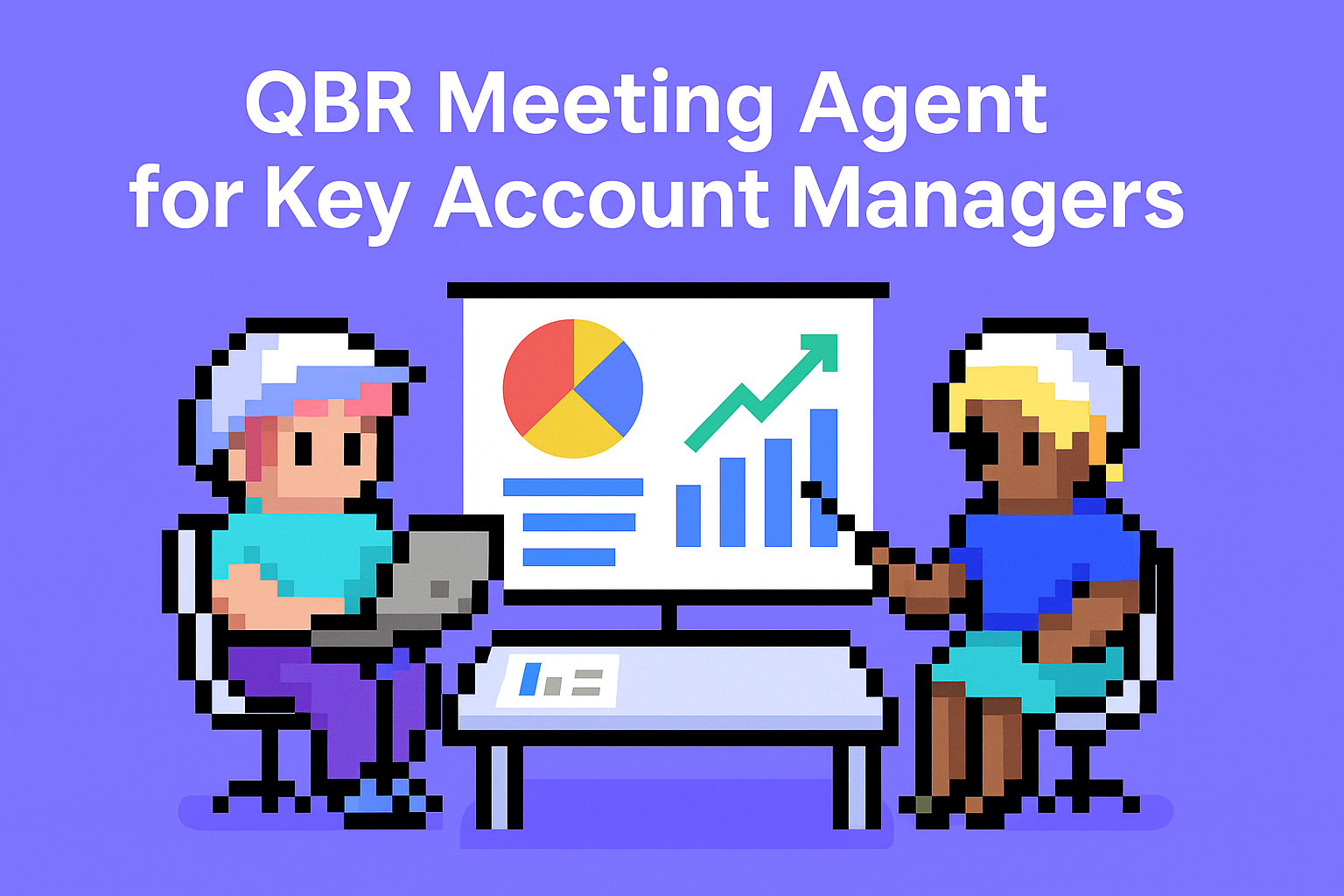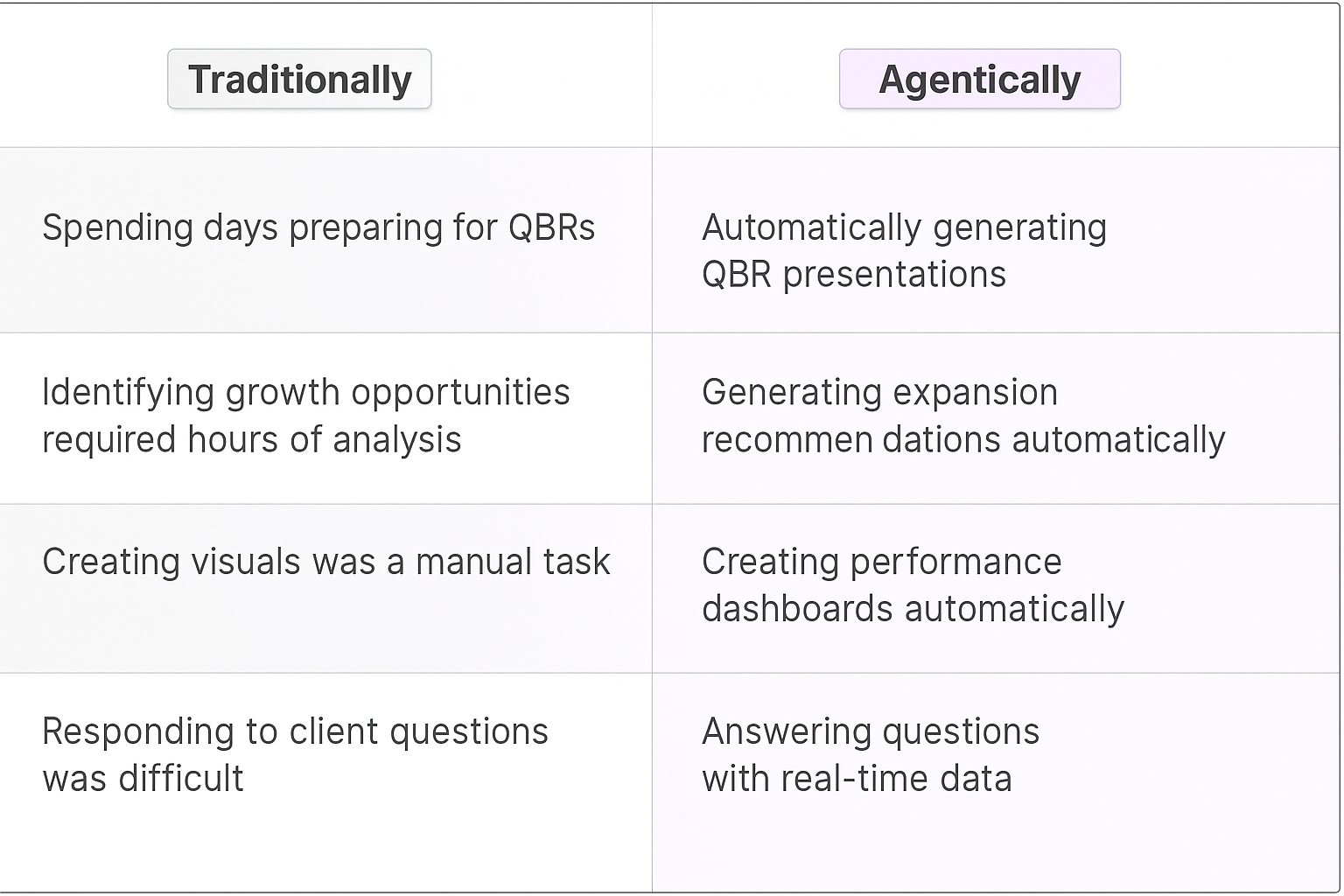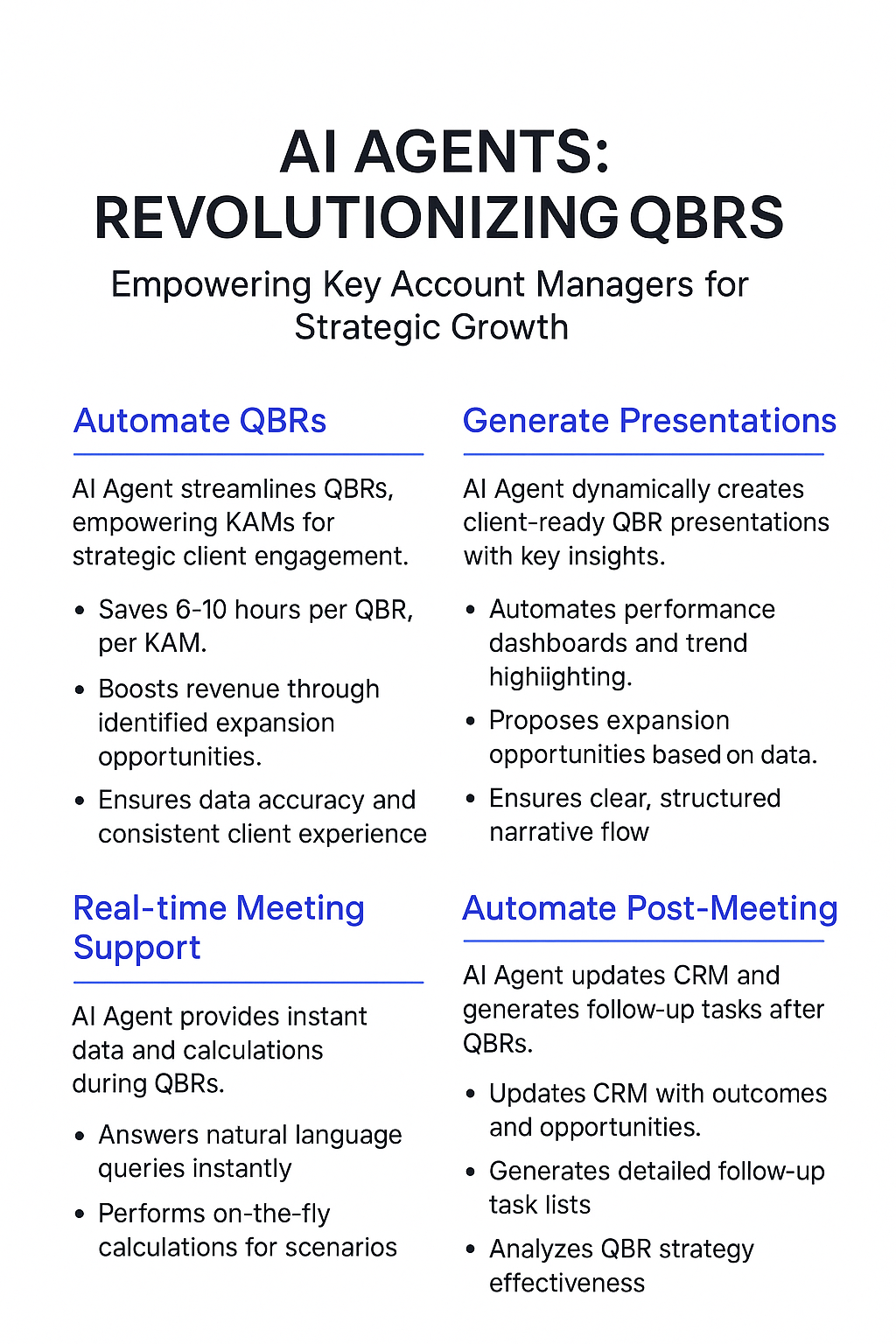
AI-powered meeting planner agents are revolutionizing how Key Account Managers manage their QBRs, coordinate with clients, and optimize their time. These agents automate the tedious aspects of QBR preparation, from data aggregation to presentation creation, allowing managers to focus on building relationships and delivering strategic value. This technology streamlines workflows, reduces preparation time, and enhances overall client satisfaction.
Before Meeting
Your AI agent automatically compiles client performance data, usage metrics, and business outcomes from the past quarter. You walk into the meeting with a comprehensive QBR presentation that highlights key trends, competitive benchmarks, and expansion recommendations.
During Meeting
As the QBR progresses, your AI agent provides real-time data support, answering client questions with precise metrics and generating action items automatically. It can instantly pull historical data, calculate custom ROI scenarios, and create follow-up proposals on the spot.
After Meeting
Post-meeting, your AI agent automatically updates the CRM with meeting outcomes, creates follow-up task lists, and begins monitoring the agreed-upon KPIs for the next quarter. It also identifies which QBR strategies were most effective for future meetings.
What you’ll need
You don't need to be a developer to set up this integration. Follow this simple guide to get started:
- Meeting Notetaker Agent template
- Calendar account
- Meetings to join
- Relevance AI Account

Who this agent is for
This agent is designed for Key Account Managers, Sales Directors, Customer Success Managers, and anyone responsible for conducting Quarterly Business Reviews with key clients. It's ideal for individuals and teams who need to present performance data, identify growth opportunities, and build strong relationships with their clients. Whether you're managing a portfolio of strategic accounts or leading a team of account managers, this agent simplifies QBR preparation and ensures that your meetings are focused on delivering maximum value.
How this agent makes meeting planning easier
Automate data aggregation and analysis
Instead of manually gathering data from various systems, the agent automatically aggregates client performance data, usage metrics, and business outcomes from the past quarter. This saves significant time and reduces the risk of errors through automated data aggregation.
Generate client-ready presentations
The agent automatically creates a comprehensive QBR presentation that includes automated performance dashboards, trend analysis, competitive benchmarking, and specific expansion recommendations through advanced data analysis.
Provide real-time data support
During the QBR, the agent provides real-time data support, answering client questions with precise metrics and generating action items automatically. It can instantly pull historical data, calculate custom ROI scenarios, and create follow-up proposals on the spot.
Automate follow-up tasks
After the meeting, the agent automatically updates the CRM with meeting outcomes, creates follow-up task lists, and begins monitoring the agreed-upon KPIs for the next quarter.
Benefits of AI Agents for Key Account Managers
What would have been used before AI Agents?
Key Account Managers traditionally relied on manual data gathering, spreadsheet analysis, and slide deck creation to prepare for QBRs. This process was time-consuming, prone to errors, and often resulted in generic presentations that lacked strategic insight. They would spend valuable time wrestling with data instead of focusing on building relationships and delivering value to their clients.
What are the benefits of AI Agents?
AI agents offer a streamlined and automated approach to QBR preparation, freeing up Key Account Managers to focus on more strategic tasks. The most significant benefit is the time saved by automating data analysis and presentation creation. The agent handles everything from data aggregation to trend identification, reducing the administrative burden on the manager.
AI agents also provide deeper insights by analyzing data from multiple sources and identifying hidden patterns. This enables managers to deliver more strategic recommendations and demonstrate the value of their services. Furthermore, the agent improves communication by providing real-time data support during the QBR, ensuring that all client questions are answered accurately and efficiently.
By automating follow-up tasks, the agent ensures that action items are tracked and that progress is monitored. This helps to keep projects on track and strengthens the client relationship. Ultimately, AI agents enhance productivity, improve client satisfaction, and allow Key Account Managers to focus on driving revenue growth.
Traditional vs Agentic meeting planning
Traditionally, Key Account Managers spent days preparing for each QBR, manually compiling data and creating presentations. Now, AI agents automate this, freeing up time for strategic client engagement. Before, identifying growth opportunities required hours of spreadsheet analysis. With an agent, expansion recommendations are generated automatically, based on client usage patterns. Creating compelling visuals used to be a manual task. Now, the agent creates automated performance dashboards that highlight key trends. Responding to client questions during the QBR was often challenging, requiring on-the-spot calculations. The agent provides real-time data support, answering questions with precise metrics. Finally, following up on action items was a manual process, often forgotten. The agent automates follow-up tasks, ensuring that nothing falls through the cracks.

Tasks that can be completed by a QBR Agent
Key Account Managers juggle numerous tasks, from building client relationships to managing projects and driving revenue growth. A QBR agent can handle many of the administrative tasks associated with preparing for and conducting QBRs, allowing managers to focus on their core responsibilities.
Data Aggregation and Analysis
The agent automatically aggregates client performance data, usage metrics, and business outcomes from various systems.
Presentation Creation
The agent generates a comprehensive QBR presentation that includes automated performance dashboards, trend analysis, and competitive benchmarking.
Expansion Opportunity Identification
The agent identifies specific expansion recommendations based on client usage patterns and business needs.
Real-Time Data Support
The agent provides real-time data support during the QBR, answering client questions with precise metrics.
Action Item Tracking
The agent tracks action items and sends follow-up reminders to ensure that tasks are completed on time.
CRM Updates
The agent automatically updates the CRM with meeting outcomes and follow-up tasks.
Risk Assessment
The agent assesses the risk of contract renewal based on client performance and engagement.
Competitive Benchmarking
The agent benchmarks client performance against industry standards to identify areas for improvement.

Things to Keep in Mind When Building a QBR Agent
Building an effective QBR agent requires careful planning and attention to detail. The goal is to create an agent that seamlessly integrates with your existing workflows and provides a user-friendly experience for both you and your clients.
Define Clear Objectives
Before you start building your agent, define clear objectives for what you want it to achieve. Do you want to reduce preparation time, improve client engagement, drive revenue growth, or all of the above? Having clear objectives will help you prioritize features and measure success.
Integrate with Existing Systems
Ensure that your agent integrates seamlessly with your CRM, data analytics platforms, and other relevant systems. This will allow it to access the data it needs to generate accurate and insightful reports.
Prioritize User Experience
Make sure that the agent is easy to use and intuitive. The interface should be clean and uncluttered, and the QBR preparation process should be straightforward and efficient.
Automate Data Analysis
Configure the agent to automatically analyze client performance data and identify key trends. This will save you time and ensure that you don't miss any important insights.
Provide Customizable Reports
Allow users to customize the agent's reports to match their specific needs. This might include selecting which metrics to display, choosing different chart types, and adding custom annotations.
Test Thoroughly
Before you roll out the agent to your entire team, test it thoroughly to ensure that it is working correctly and that it meets your objectives. Gather feedback from users and make any necessary adjustments.
Continuously Improve
Once your agent is live, continue to monitor its performance and gather feedback from users. Use this information to identify areas for improvement and make ongoing enhancements.
The Future of AI Agents in Meeting Planning
The future of AI agents in QBR planning is bright, with advancements in natural language processing, machine learning, and artificial intelligence promising to further streamline and enhance the QBR process. Future agents will be able to understand complex client needs, anticipate potential challenges, and proactively suggest solutions.
AI agents will also become more personalized, learning individual client preferences and tailoring their recommendations accordingly. They will be able to identify preferred communication styles, preferred meeting formats, and even preferred topics of discussion, creating a more seamless and engaging experience.
Furthermore, AI agents will play a larger role in facilitating collaboration and communication during QBRs. They will be able to transcribe meeting minutes, track action items, and even provide real-time translation services, making QBRs more productive and inclusive.
AI agents will also integrate with other business applications, such as project management tools and marketing automation platforms, providing a holistic view of client-related activities and enabling better decision-making.
Ultimately, the future of AI agents in QBR planning is about creating intelligent systems that not only automate the QBR process but also enhance client relationships, improve communication, and drive better business outcomes.









